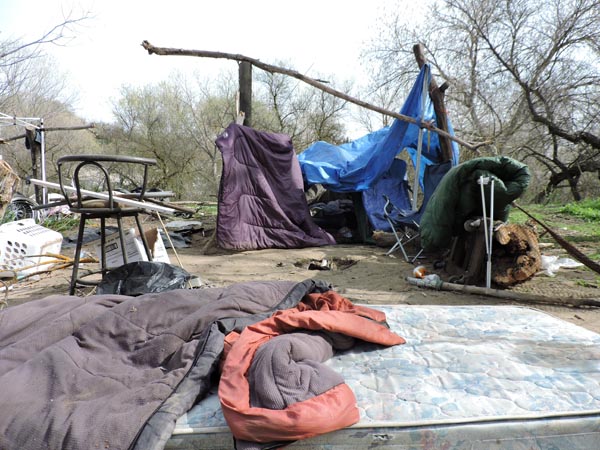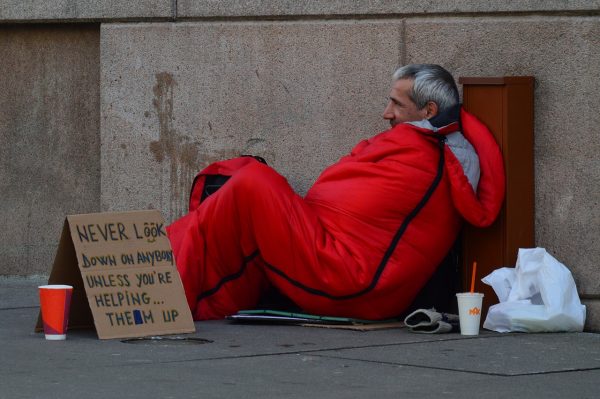Editorial: The solution to homelessness can be simple
What is the editor’s view on homelessness in Paso Robles?
–This week, the Paso Robles Daily News, and specifically myself, the editor of this publication, were accused of having a secret, anti-homeless agenda.
“Paso News only puts out letters to fit the agenda, and it’s to benefit a few not the citizens as a whole,” wrote Facebook user Kyle Harmon.
“To the editor: how about you quit using others to push your publication’s objectives and sign your name to an article calling for the criminalization of poverty and addiction. Garbage rag,” wrote Facebook follower Morgan Condict.
We were also tagged by Facebook user Megan Thorpe Tannehill, who accused us of running the same letter multiple times under different headlines: “STOP IT!!! This is the same letter you’ve posted several times with controversial headlines that are deceiving and misleading. Talk about terrible journalism!! Shame on you.”
So in response, as the editor, is my secret agenda to advocate against basic human rights such as food and shelter for the disadvantaged in this community and drive them out somewhere else so that they can be “someone else’s problem?”
Short answer is no: in no way, shape of form does that describe my feelings on this complex issue. And I will get to the long answer, but first I’d like to get one thing clear: Letters written to me are not letters written by me. Also, to clarify, there have, so far this week, been four letters published, each by separate authors with different views:
- Letter: Distressed to see the state of homelessness in Paso Robles
- Letter: We are making the homeless too comfortable
- Letter: Homeless should be removed to protect residents, tourists
- Letter: Saying the homeless should be pushed out it short sighted and cruel
Is it my duty to censor people’s opinions in the opinion section of this site? Absolutely not. In fact, it’s the opposite. Our duty as a public forum in a free speech country is to be unbiased in what we publish.
The exception to news not being a reflection of our opinion would be an editorial, which is what I’m writing now. An editorial is the view of the writer, in this case, me, the editor, and the opinions in the opinion section are just that: opinions. We run typically 8-12 stories per day, sometimes one or two of these are letters submitted by readers. The letters need to be signed with a first and last name, include the city you are from, be about a local topic, and can’t contain profanity, slander, libel, or direct attacks. (See form here).
The Paso Robles Daily News is actually a small local company run by a local family, not a big media conglomerate. I’ve been in this industry for almost a decade, over four years with the Paso Robles Daily News. I was told this week that I should be ashamed for working at this publication and that I should fight my publisher for the right to censor letters when they come in and are hateful.
But I agree 100-percent with our principles and what I have been taught here and take pride in working for a company that told me specifically to “try not to have an opinion and post both sides,” as opposed to the one that told me to run specific opinions and stories to appease the assumed bias of the North County audience. I understand the importance of free speech and an open, public forum. I think it’s important to see what people believe in this community, sometimes especially if it’s hateful.
So here’s my secret agenda: to show you, the readers, what people are saying or doing in the hopes that you would read the letters, potentially be shocked, and write letters in return, (or perhaps even turn up at a city council meeting and let your voice be heard to someone that can do something about it.) Instead, readers attacked this paper, and myself directly, unfollowed us, and even gave us some bad reviews on the way out based on an inaccurate assumption.

One of dozens of homeless encampments in the Salinas riverbed.
It’s a human rights issue
I think that homelessness is, at its basic level, a human rights issue. But what are basic human rights?
The UN states that: “Human rights are rights inherent to all human beings, regardless of race, sex, nationality, ethnicity, language, religion, or any other status. Human rights include the right to life and liberty, freedom from slavery and torture, freedom of opinion and expression, the right to work and education, and many more.”

Abraham Maslow’s hierarchy of needs: Needs lower down in the hierarchy must be met before individuals can attend to needs higher up. Image courtesy www.simplypsychology.org.
Without fundamental needs, people cannot achieve what physiologist Abraham Maslow termed, “self-actualization,” ie: being the best one can be. Therefore, from a psychological standpoint, one could easily argue that the fundamental needs, such as food, water, housing, and medical care, would be the pillar to the ability to pursue freedom, life, and liberty.
I also know from experience how, when you are working multiple jobs and barely getting by, or even if you are really pushing hard and succeeding, that someone asking for a handout can sting. And it’s become pretty clear to me that people want to be protected from the truth when it gets less than shiny.
But the idea that humans, who have inherent value, need to be “swept away,” is not a solution in any way. And we compare them to animals or things, it makes them become easier to hate. (Which is upsettingly familiar to many other fear-based, dehumanizing social control campaigns throughout history.)
It could happen to anybody
On a personal note, I have had some experience with homelessness as a teen. My mother and I spent about six months alternating between sleeping at a local campground or sleeping in her Jeep. My mother was going through cancer treatments at the time and couldn’t physically work. She was a single mom, divorced, both her parents had just died of cancer. I was 15, attending a local high school at the time, and working at a restaurant to help buy food for us to eat and put gas in the car. But my part-time job and her disability check didn’t cut it. By the time I started attending Cuesta College, my mother was battling homelessness again, sick with another round of cancer. After my roommates and landlord kicked her off my couch, she was sleeping in her Jeep with her two dogs. She went quickly from having nowhere to go, to checking into the hospital, to checking into hospice and then passing away.
The guilt and shame I have for her spiral was, and still is, intense. What if she had somewhere to go? What if a younger me had been able to afford to take care of her better somehow? Should we have moved out of the state even though she wanted to stay with her Central Coast doctors? When people say, “it should be the responsibility of the family to take care of them,” what if the only living family are still children? Or what if there is no family at all, or if their family is also struggling with poverty?
Unfortunately, this story isn’t uncommon. In fact, I have a friend whose mother suffered almost the same downward spiral. It could happen to anyone, especially in this community. Who on a disability paycheck can afford to live in San Luis Obispo County? And this is just my family’s story. There are many paths to homelessness, and each one will break your heart if you allow yourself to see them not through fear and judgment but with understanding.
It’s a mental health issue
According to the National Coalition for the Homeless, up to 25-percent of people living on the street are mentally ill. We in this country look at mentally ill people differently than people who have other illnesses. If people were walking around seeking medical care for bleeding wounds or even chronic diseases doctors are ethically obligated to give them the care they need.
There was a time where the mentally ill were institutionalized, but in the last few decades we have seen a trend toward deinstitutionalization of psychiatric patients. While perhaps well-intentioned – because conditions within the psych hospitals of old were dangerously dire and people were being committed against their will – the movement away from involuntarily committing patients has caused an upward tick in people with severe mental illness ending up on the street, and often into jail. And I think many are aware of the multiple local cases of what are, in my opinion, nothing short of the torture of mentally ill people who were incarcerated.
Yet we continue to step over them, keep the same people in office, defend the status quo, and continue “following orders,” rather than looking at the humanity behind the orders themselves and asking if the system is actually working for anyone at all.
It’s connected to cost of living
I remember interviewing a candidate for CA Senator a few years ago during his campaign. I asked him about a theory that I had, “Is homelessness connected to cost of living, do you think?” He said, “You tell me.” Upon which I responded to him that actually I was the one conducting the interview and he would be the one to address the problems as a senator so no, actually, I’d prefer if he could give me an answer. He couldn’t provide one – said he’d look into it.
This candidate was extremely wealthy and from the Bay Area. I was surprised that when I posed this question to many candidates running during the last election that they acted that they just now thought maybe there was a connection to people being homeless because they literally could not afford a place to live.
Our county is beautiful, and I’m a third generation Central Coaster and passionate lover of my home, but I see us cling to titles like “the happiest place in America” or “the new Napa,” and overlook the less glamorous, “one of the highest rates of income disparity in the country.”
Here’s what’s working in other areas
Turns out, my theory of the connection to of affordability and homelessness is absolutely nothing new, “The fundamental cause of homelessness is the widening housing affordability gap,” according to the Coalition for the Homeless. “At the same time that housing affordability has worsened, government at every level has cut back on already-inadequate housing assistance for low-income people and has reduced investments in building and preserving affordable housing.”
So what is the solution to homelessness? It’s actually poetically simple: It’s providing them with a home.
“Numerous research studies have consistently confirmed that long-term housing assistance not only successfully reduces homelessness — it is also less expensive than shelter and other institutional care,” says the Coalition for the Homeless.
And this solution actually can benefit everybody. “Handing mentally ill substance abusers the keys to a new place may sound like an example of wasteful government spending. But it turned out to be the opposite: over time, Housing First has saved the government money,” writes James Surowiecki in a story done for the New Yorker about Utah’s Housing First initiative that reduced homelessness in Utah by 91-percent in 10 years.
“…The cost of shelters, emergency-room visits, ambulances, police, and so on quickly piles up. Lloyd Pendleton, the director of Utah’s Homeless Task Force, told me of one individual whose care one year cost nearly a million dollars, and said that, with the traditional approach, the average chronically homeless person used to cost Salt Lake City more than twenty thousand dollars a year. Putting someone into permanent housing costs the state just eight thousand dollars, and that’s after you include the cost of the case managers who work with the formerly homeless to help them adjust. The same is true elsewhere. A Colorado study found that the average homeless person cost the state forty-three thousand dollars a year, while housing that person would cost just seventeen thousand dollars.”
Unfortunately, Utah’s success is now seeing a decline from lack of funds. “The only thing I’ve ever seen that really worked in terms of reducing the number of people on the street was the Housing First policy,” said Glenn Bailey, who directs Crossroads Urban Center, a Salt Lake City food pantry, in a story done for NPR. “The mistake we made was stopping.”
The solution doesn’t need to come only from the government. We can look to successes from the private sector and nonprofits as well. In Austin, the Community First! Village is an intentionally planned community that lifts the chronically homeless up off the streets. Once complete, nearly 500 formerly homeless individuals will be living in Community First!—representing about 40 percent of Austin’s chronically homeless population:
Choosing love over fear
I know there are a lot of barriers to this in our county. Maybe this issue is so painful because even those of us with multiple jobs can’t afford “long-term housing” for ourselves, so we can’t begin to think about helping other people. But this solution really is as simple as feeding people who are hungry, or giving medical care to those who are sick: house the homeless.
I believe that all thoughts carry energy with them. Most thoughts either stem from love or from fear. Compassion is love, and that’s what we need to tune into to come together as a community. Judgment is fear-based thinking and will not lead to solutions: When we are in judgment, we can’t be in love.
A community cannot thrive, humans cannot thrive, without basic dignities. Maybe it’s time for us to start relying on each other, not shaming each other when we ask for help. Maybe it’s finally time that we start looking at ways where we could all feel safer, happier, in a community that we feel like, at least at some small, basic level, will take care of us.
-Skye Pratt
Editor, Paso Robles Daily News
Resources and services
- ECHO Shelter
- Loaves and Fishes Paso Robles
- Food Bank Coalition
- RISE
- Community Action Partnership of San Luis Obispo County
- ECHO-El Camino Homeless Organization
- Housing Authority of San Luis Obispo (HASLO)
- Habitat for Humanity for San Luis Obispo County
- Mental Health Services
- Community Health Centers of the Central Coast
- Food Bank of San Luis Obispo
- United Way 2-1-1 services






















